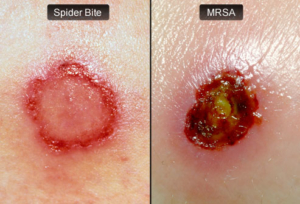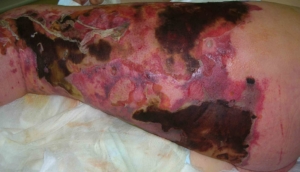In our first article we highlighted what MRSA is and its various definitions.
In this article we shall look at the symptoms of Infections by Staphylococcus aureus bacterium and Methicillin – resistant Staphylococcus aureus – MRSA.
Symptoms of MRSA will vary and is dependent upon which area of the body is affected with the MRSA or staph infection.

The most common symptom of MRSA presents itself as a skin infection. Very often this appears as an abscess or perhaps a boil. Many look like a spider bite.
If MRSA has infected a surgical or accidental wound, the symptoms of the surrounding area would be painful and red in colour with swelling and pus.
Urinary tract infections and bacteraemia (blood poisoning) can also be caused by MRSA infection.
One of the worst infections is when staph bacteria enter the lungs and cause pneumonia. The symptoms of this infection are normally a high fever and difficulty in breathing.

Staph infection can in certain cases, result in what people call a “flesh eating bug” type of bacterium being developed. These bacterium are called “necrotizing fasciitis” (see picture opposite) but are very rare. “Flesh eating bacterium” however, is not an accurate term. The bacterium do not actually consume the tissue. They actually cause the destruction of skin and muscle by releasing toxins (virulence factors).
These include streptococcal pyogenic exotoxins and other virulence factors. S. pyogenes produces an exotoxin known as a superantigen. This toxin is capable of activating T-cells non-specifically. This causes the overproduction of cytokines that over-stimulate macrophages. The macrophages cause the actual tissue damage by releasing oxygen free radicals.
Staphylococcus aureus has been rapidly spreading world-wide and certain strains have become drug resistant to many antibiotics. This seems on course to become an even greater problem in the future. Some researchers and reporters have suggested an enormous growth of MRSA infections in the next few years, as medications become more difficult to find and new strains of MRSA evolve.
As already mentioned, MRSA symptoms can vary and are usually spread by contact with contaminated items or people. Dependant upon the strain, some are fully treatable while others may cause concern to life. Hospitals, Prisons, Gymnasiums, Care Homes, Nursing Homes, in fact, anywhere where contact may be shared with other people or items, are the most likely places to contract a staph infection.
In our next Article we shall cover some of the traditional treatments of MRSA.


Hi,
what with Christmas & New Year etc. Richard has been battling with time and this has unfortunately slipped as the earliest he has managed to get an interview with his main contact on Nano Silver is sometime next week!
There is however an article on Nano Silver on our site at:
https://www.illuminatisilver.com/premium-articles/antibacterial-efficacy-of-gold-and-silver-nanoparticles/
I hope this helps in the meantime.
Regards,
Greg
Yes cabadejo very shortly – later this week – another article tomorrow and then details either Thursday or Friday – we are now starting to catch up and will be fully up to date by the end of the week.
Bacteriaemia is generally harmless – you can for example get bacteriaemia brushing your teeth. Exacept perhaps if you have heart value damage post Rheumatic Fever you are at risk from bacteriaemia causing endocarditis, hence prophylactic antibiotics are recommended prior to dental treatment. Blood poisoning is septicaemia where bacteria was multiplying in the blood. Here the infection has overwhelmed the body’s defence systems.
Will we get to hear about manufacture of nano silver?